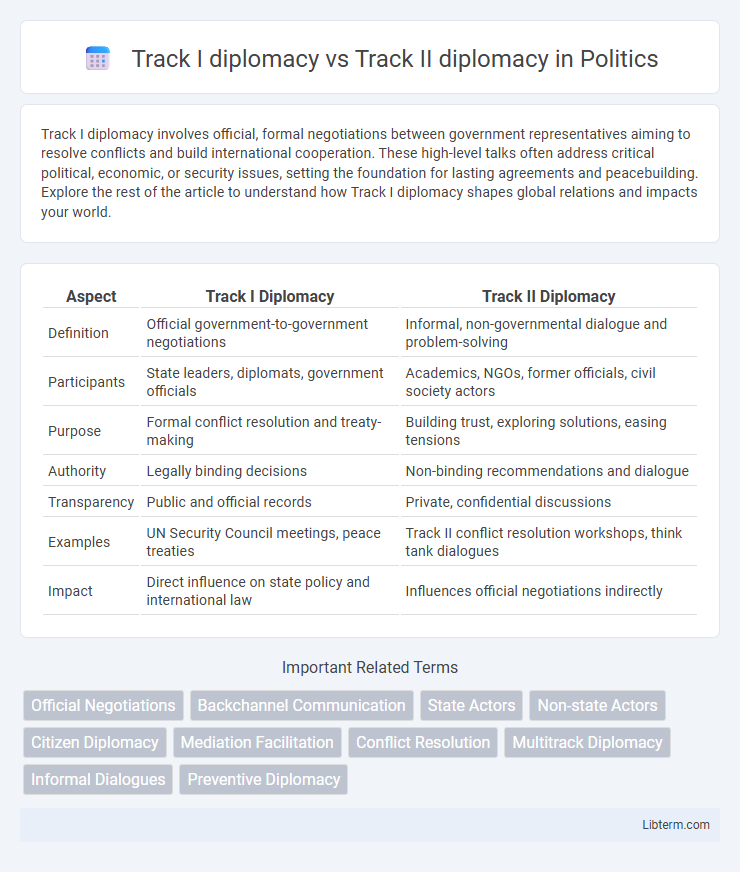Track I diplomacy involves official, formal negotiations between government representatives aiming to resolve conflicts and build international cooperation. These high-level talks often address critical political, economic, or security issues, setting the foundation for lasting agreements and peacebuilding. Explore the rest of the article to understand how Track I diplomacy shapes global relations and impacts your world.
Table of Comparison
| Aspect | Track I Diplomacy | Track II Diplomacy |
|---|---|---|
| Definition | Official government-to-government negotiations | Informal, non-governmental dialogue and problem-solving |
| Participants | State leaders, diplomats, government officials | Academics, NGOs, former officials, civil society actors |
| Purpose | Formal conflict resolution and treaty-making | Building trust, exploring solutions, easing tensions |
| Authority | Legally binding decisions | Non-binding recommendations and dialogue |
| Transparency | Public and official records | Private, confidential discussions |
| Examples | UN Security Council meetings, peace treaties | Track II conflict resolution workshops, think tank dialogues |
| Impact | Direct influence on state policy and international law | Influences official negotiations indirectly |
Introduction to Track I and Track II Diplomacy
Track I diplomacy involves official, government-to-government negotiations led by formal representatives such as diplomats, heads of state, or foreign ministers aiming to resolve conflicts through established political channels. Track II diplomacy consists of informal, non-governmental dialogues facilitated by academics, retired officials, or civil society leaders focusing on building trust and exploring creative solutions outside official protocols. Both tracks complement each other, with Track I providing authoritative decision-making and Track II fostering grassroots communication and problem-solving.
Defining Track I Diplomacy
Track I diplomacy refers to official, formal negotiations conducted between recognized government representatives or state actors aimed at resolving conflicts and fostering cooperation on national or international levels. This diplomatic channel involves structured dialogue, treaties, and policy agreements with legally binding consequences under international law. Track I diplomacy contrasts with Track II diplomacy, which involves informal, non-governmental interactions designed to complement official efforts by building trust and exploring solutions outside formal negotiations.
Defining Track II Diplomacy
Track II diplomacy involves informal, unofficial dialogues between non-governmental actors such as academics, retired officials, and civil society representatives aimed at building trust and exploring solutions in conflict resolution. Unlike Track I diplomacy, which is conducted by official government representatives with formal authority, Track II provides a flexible environment for creative problem-solving and confidence-building measures outside of formal negotiations. This approach often complements official efforts by addressing sensitive issues and fostering mutual understanding in protracted conflicts.
Key Differences Between Track I and Track II Diplomacy
Track I diplomacy involves official government representatives engaging in formal negotiations to resolve conflicts or establish agreements, relying on official mandates and authority. Track II diplomacy consists of non-governmental actors such as academics, former officials, and civil society leaders who facilitate informal dialogue and confidence-building measures without formal decision-making power. The key differences lie in their official status, decision-making authority, and the formality of communication, with Track I being more structured and government-led, while Track II operates through unofficial, flexible channels to complement formal efforts.
Roles of Governmental Actors in Track I Diplomacy
Governmental actors in Track I diplomacy hold formal authority to negotiate, make decisions, and implement policies directly impacting international relations. Their roles include representing national interests, engaging in official dialogue, and signing binding agreements to resolve conflicts or establish cooperation. Track I diplomacy relies heavily on these actors' ability to leverage political power and diplomatic channels to achieve state-level objectives.
Role of Non-State Actors in Track II Diplomacy
Track II diplomacy involves non-state actors such as NGOs, academics, and religious leaders who facilitate informal dialogue and build trust between conflicting parties outside official government channels. These actors play a crucial role in addressing underlying social and cultural issues, promoting mutual understanding, and exploring creative solutions that formal negotiations may overlook. Their flexible, unofficial engagement often complements Track I diplomacy by creating a supportive environment for official peace processes.
Advantages and Limitations of Track I Diplomacy
Track I diplomacy involves formal negotiations between official government representatives, allowing for binding agreements and clear authority in decision-making processes. Its advantages include the ability to implement legally binding decisions and access to governmental resources, but limitations arise from rigid protocols, limited flexibility, and often heightened political pressures that can stall progress. The formal nature may restrict open dialogue and innovation compared to Track II diplomacy, which operates through informal, non-governmental channels.
Strengths and Challenges of Track II Diplomacy
Track II diplomacy leverages informal dialogues among non-governmental actors to build trust and explore creative solutions beyond official constraints. Its strengths include flexibility, the ability to engage diverse stakeholders, and fostering mutual understanding in complex conflicts. Challenges involve limited authority to enforce agreements, potential lack of transparency, and dependence on eventual government buy-in for implementation.
Synergy and Interaction Between Track I and Track II Diplomacy
Track I diplomacy involves official, government-to-government negotiations that establish formal agreements and policies, while Track II diplomacy consists of informal, non-governmental interactions that foster mutual understanding and trust. The synergy arises when Track II initiatives inform and complement Track I negotiations by providing grassroots insights, expert analysis, and innovative solutions that governments may overlook. Effective interaction between both tracks enhances conflict resolution by bridging formal authority with flexible dialogue, ultimately creating a holistic approach to peacebuilding.
Case Studies: Successful Applications of Track I and Track II Diplomacy
Track I diplomacy, characterized by official governmental negotiations, proved decisive in the Camp David Accords where U.S. President Jimmy Carter facilitated a peace treaty between Egypt and Israel in 1978. In contrast, Track II diplomacy, involving unofficial dialogues and problem-solving workshops, significantly contributed to the Northern Ireland peace process, with initiatives like the grassroots talks supported by the community-led Forum for Peace and Reconciliation. Both diplomatic approaches demonstrate unique strengths in resolving complex conflicts by combining formal authority and informal relationship-building strategies.
Track I diplomacy Infographic

 libterm.com
libterm.com